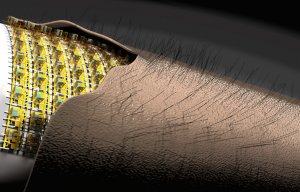
Towards tactile sensation with e-skin
DNA and glass make a surprising light and strong combination.

7th August 2023
Innovation in Textiles
|
Upton, NY, USA
Materials possessing both strength and lightness have the potential to enhance everything from automotive components to body armour but usually the two qualities are mutually exclusive.
Researchers at the University of Connecticut, Columbia University and Brookhaven National Lab have developed a highly robust material with an extremely low density by constructing a structure using DNA and subsequently coating it in glass.
The research team created a structure of self-assembling DNA based on pieces of DNA of specific lengths and chemistry which snap themselves together into the skeleton of the material.
Oleg Gang and Aaron Mickelson, nanomaterials scientists at Columbia University and Brookhaven’s Center for Functional Nanomaterials then coated the DNA with a very thin layer of glass-like material only a few hundred atoms thick. The glass only coated the strands of DNA, leaving a large part of the material volume as empty space.
Glass might seem a surprising choice, as it shatters easily, but this is usually because of a flaw, such as a crack, scratch, or missing atoms in the structure. A flawless cubic centimetre of glass can withstand 10 tons of pressure, compared to iron, for example, which can take seven tons of pressure per square centimetre but is also very dense and heavy.
As long as the glass is less than a micrometre thick, it’s almost always flawless and since the density of glass is much lower than metals and ceramics, any structures made of flawless nano-sized glass should be strong and lightweight.
The DNA skeleton reinforced the glass coating making the material very strong, and the voids comprising most of the material’s volume made it lightweight. As a result, the glass nanolattice structures are four times higher in strength but five times lower in density than steel. This unusual combination of lightweight and high strength has never been achieved before.
“The ability to create designed 3D framework nanomaterials using DNA and mineralise them opens enormous opportunities for engineering mechanical properties but much research work is still needed before we can employ it as a technology,” said Gang.
The team is now working with the same DNA structure but substituting even stronger carbide ceramics for glass, and plans to experiment with different DNA structures to see which makes the material strongest. Future materials based on this concept have great promise as energy-saving materials for vehicles and other devices that prioritise strength. The team believes that DNA origami nanoarchitecture will open a new pathway to creating lighter and stronger materials than have previously been possible.

Business intelligence for the fibre, textiles and apparel industries: technologies, innovations, markets, investments, trade policy, sourcing, strategy...
Find out more